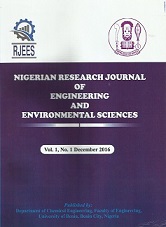Voltage Profile Enhancement on the Nigerian 330 kV Grid using Series-Shunt Reactive Power Compensation Technique
Authors: Salami HT, Aibangbee JO, Salami KB, Salami L, Abdulfatah I
DOI Info: N/A
ABSTRACT
The Nigerian 330 kV power systems is characterized by major constraints such as low voltage profile and power losses resulting in negative effects on power generation and transmission systems. This paper investigated the application of combining series and shunt compensations for enhancing the operation of the system. The load flow study using Newton-Raphson-based method was carried out to analyse the steady state operation of the system for the base case. This method converges faster and its simpler compared to other solution methods. The series compensation was incorporated, followed by the shunt compensation and then combined series and shunt compensation were incorporated into the system in sequential order. MATLAB/SIMULINK software was used to carry out the simulation analysis. The results obtained from the study revealed that the magnitude of bus voltages fall below the prescribed statutory range of 0.95<1.0<1.05 pu (that is ±5% of nominal voltage value). The combined series and shunt compensations method significantly increased power transfer and improved voltage profile of the overall Nigerian 330 kV grid network. It also showed that the operational behaviour and network performance of the Nigerian power system can be significantly improved.
Affiliations: Department of Electrical/Electronics and Computer Engineering, Bells University of Technology, Ota, Ogun State, Nigeria.
Keywords: Base Case, Compensation, Power System, Series, Shunt, Solution
Published date: 2020/12/30









